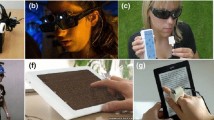Abstract
In order to help the visually impaired as they navigate unfamiliar environment such as public buildings, this paper presents a novel smart phone, vision-based indoor localization, and guidance system, called Seeing Eye Phone. This system requires a smart phone from the user and a server. The smart phone captures and transmits images of the user facing forward to the server. The server processes the phone images to detect and describe 2D features by SURF and then matches them to the 2D features of the stored map images that include their corresponding 3D information of the building. After features are matched, Direct Linear Transform runs on a subset of correspondences to find a rough initial pose estimate and the Levenberg–Marquardt algorithm further refines the pose estimate to find a more optimal solution. With the estimated pose and the camera’s intrinsic parameters, the location and orientation of the user are calculated using 3D location correspondence data stored for features of each image. Positional information is then transmitted back to the smart phone and communicated to the user via text-to-speech. This indoor guiding system uses efficient algorithms such as SURF, homographs, multi-view geometry, and 3D to 2D reprojection to solve a very unique problem that will benefit the visually impaired. The experimental results demonstrate the feasibility of using a simple machine vision system design to accomplish a complex task and the potential of building a commercial product based on this design.











Similar content being viewed by others
References
National Federation of the Blind: The Braille Literacy Crisis in America: Facing the Truth, Reversing the Trend, Empowering the Blind. http://www.nfb.org/images/nfb/documents/word/The_Braille_Literacy_Crisis_In_America.doc (2009)
R.N.I. for the Blind: Blind and Partially Sighted Adults in Britain: v. 1: The R.N.I.B. Survey. Stationery Office Books, London (1991)
Shoval, S., Ulrich, I., Borenstein, J.: NavBelt and the Guide–Cane. IEEE Robot. Autom. Mag. 10(1), 9–20 (2003)
Upson, S.: Tongue vision: a fuzzy outlook for an unpalatable technology. Spect. IEEE 44(1), 44–45 (2007)
Golledge, R.G., Marston, J.R., Loomis, J.M., Klatzky, R.L.: Stated preferences for components of a personal guidance system for nonvisual navigation. Design 98, 135–147 (2004)
Xu, J., Fang z. G., Dong D. H., Zhou F.: An outdoor navigation aid system for the visually impaired. In: 2010 IEEE International Conference on Industrial Engineering and Engineering Management (IEEM), pp. 2435–2439 (2010)
Sanchez, J.H., Aguayo, F.A., Hassler, T.M.: Independent outdoor mobility for the blind. Virtual Rehabil. 2007, 114–120 (2007)
Moulton, B., Pradhan, G., Chaczko, Z., Moulton, B., Pradhan, G., Chaczko, Z.: Voice operated guidance systems for vision impaired people: investigating a user-centered open source model. JDCTA 3(4), 60–68 (2009)
Moulton, B., Pradhan, G., Chaczko, Z., Moulton, B., Pradhan, G., Chaczko, Z.: Voice operated guidance systems for vision impaired people: investigating a user-centered open source model. JDCTA 3(4), 60–68 (2009)
Tatsumi H., Murai Y., Araki T., Miyakawa M.: RFID localization for the visually impaired. In: Automation Congress, 2008. WAC 2008. pp. 1–6 (2008)
Yelamarthi K., Haas D., Nielsen D., Mothersell S.: RFID and GPS integrated navigation system for the visually impaired. In: 2010 53rd IEEE International Midwest Symposium on Circuits and Systems (MWSCAS), pp. 1149–1152 (2010)
Kulyukin V., Gharpure C., Nicholson J., Pavithran S.: RFID in robot-assisted indoor navigation for the visually impaired. In: 2004 IEEERSJ International Conference on Intelligent Robots and Systems. vol. 2, no. 6, pp. 1979–1984 (2004)
Na J.: The blind interactive guide system using RFID-based indoor positioning system. In: Miesenberger, K., Klaus, J., Zagler, W. L., Karshmer. A. I. (eds.) Computers Helping People with Special Needs, vol. 4061. Springer, Berlin, pp. 1298–1305 (2006)
Tjan, B.S., Beckmann, P.J., Roy, R., Giudice, N., Legge, G.E.: Digital sign system for indoor way finding for the visually impaired. In: Proceedings of the 2005 IEEE Computer Society Conference on Computer Vision and Pattern Recognition—Workshops, San Diego, CA, USA (2005)
Coughlan, J., Manduchi, R., Shen, H.: Cell phone-based wayfinding for the visually impaired. In: Presented at the 1st International Workshop on Mobile Vision, Graz, Austria (2006)
Biswas, J., Veloso, M.: WiFi localization and navigation for autonomous indoor mobile robots. In: 2010 IEEE International Conference on Robotics and Automation (ICRA), pp. 4379–4384 (2010)
Inoue, Y., Ikeda, T., Yamamoto, K., Yamashita, T., Sashima, A., Kurumatani, K.: Usability study of indoor mobile navigation system in commercial facilities. In: Proceedings of the Second International Workshop on Ubiquitous Systems Evaluation USE 2008 (2008)
Kulyukin, V., Gharpure, C., Nicholson, J., Osborne, G.: Robot-assisted wayfinding for the visually impaired in structured indoor environments. Auton. Robots. 21(1), 29–41 (2006)
Anjum, S.: Place recognition for indoor blind navigation. Senior Honoris Thesis, 2010–2011, Carnegie Mellon University in Qatar. http://www.cs.cmu.edu/afs/cs/user/mjs/ftp/thesis-program/2011/theses/qatar-anjum.pdf
Davison, A.J., Reid, I.D., Molton, N.D., Stasse, O.: MonoSLAM: real-time single camera SLAM. IEEE Trans. Pattern Anal. Mach. Intell. 29, 1052–1067 (2007)
Longuet-Higgins, H.C.: A computer algorithm for reconstructing a scene from two projections. Nature 293(5828), 133–135 (1981)
Hartley, R., Zisserman, A.: Multiple View Geometry in Computer Vision. Cambridge University Press, Cambridge (2003)
MorJ, J.: The Levenberg–Marquardt algorithm: implementation and theory. In: Watson, G.A. (ed.) Numerical Analysis, vol. 630. Springer, Berlin, pp. 105–116 (1978)
Bay, H., Ess, A., Tuytelaars, T., Van Gool, L.: Speeded-up robust features (SURF) original publication. Comput. Vis. Image Underst. 110(3), 346–359 (2008)
Lowe, D.G.: Object recognition from local scale-invariant features. In: The Proceedings of the Seventh IEEE International Conference on Computer Vision, vol. 2, pp. 1150–1157 (1999)
Acknowledgments
The authors gratefully acknowledge the financial support of National Science Foundation of China (No. 61100170) and the Fundamental Research Funds for the Central Universities of China (No. 12lgpy37). They are especially grateful to the anonymous reviewers of this paper for their invaluable comments.
Author information
Authors and Affiliations
Corresponding author
Rights and permissions
About this article
Cite this article
Zhang, D., Lee, DJ. & Taylor, B. Seeing Eye Phone: a smart phone-based indoor localization and guidance system for the visually impaired. Machine Vision and Applications 25, 811–822 (2014). https://doi.org/10.1007/s00138-013-0575-0
Received:
Revised:
Accepted:
Published:
Issue Date:
DOI: https://doi.org/10.1007/s00138-013-0575-0




